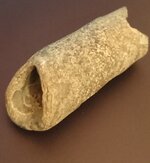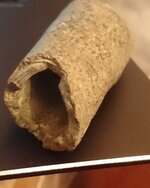Hi everyone!
I discovered this tubular, small rock a few years ago and stumbled across it just recently emptying some boxes, when it struck me that I really don't know much about it.
It is approximately 3cm long and 1cm in diameter. Both ends are uneven but one is smoothed/eroded/soft and the other feels quite sharp and fractured. The wall is of uniform thickness (~ 2-3mm). I know nothing about rocks or metals so I cannot tell you much about the material, except that it is solid and hard. The surface is not rough but also not perfectly smooth... perhaps textured/split/broken but smoothed.
I found the object in an Italian riverbed (probably caused smoothness of surface and one end through erosion); I will not disclose the exact location for now.
I speculated whether it was part of some sort of man-made tubing/ducting system but the material seems somewhat unusual and perhaps outdated for such a purpose (could it be an old lead pipe?? I doubt this, but wouldn't rule it out). The tubular shape of my rock initially led me to believe it could not have been formed by nature, especially due to the uniformity of the opening and the interior but perhaps the rock contained something which may have rotted over time, such as wood? Is this possible?
I'm very curious about your thoughts/ideas/suggestions! Please ask about extra detail.
- S
I discovered this tubular, small rock a few years ago and stumbled across it just recently emptying some boxes, when it struck me that I really don't know much about it.
It is approximately 3cm long and 1cm in diameter. Both ends are uneven but one is smoothed/eroded/soft and the other feels quite sharp and fractured. The wall is of uniform thickness (~ 2-3mm). I know nothing about rocks or metals so I cannot tell you much about the material, except that it is solid and hard. The surface is not rough but also not perfectly smooth... perhaps textured/split/broken but smoothed.
I found the object in an Italian riverbed (probably caused smoothness of surface and one end through erosion); I will not disclose the exact location for now.
I speculated whether it was part of some sort of man-made tubing/ducting system but the material seems somewhat unusual and perhaps outdated for such a purpose (could it be an old lead pipe?? I doubt this, but wouldn't rule it out). The tubular shape of my rock initially led me to believe it could not have been formed by nature, especially due to the uniformity of the opening and the interior but perhaps the rock contained something which may have rotted over time, such as wood? Is this possible?
I'm very curious about your thoughts/ideas/suggestions! Please ask about extra detail.
- S






 . It may also be worth pointing out that at the fractured end, one can recognise the material seems to be layered. Could this be a soda straw feature?
. It may also be worth pointing out that at the fractured end, one can recognise the material seems to be layered. Could this be a soda straw feature?  ...It was in an Italian riverbed flowing through the ancient Etruscan town of Vulci. It is a major archaeological site, although the exact location of my find was a little further from the excavations and main part of the town.
...It was in an Italian riverbed flowing through the ancient Etruscan town of Vulci. It is a major archaeological site, although the exact location of my find was a little further from the excavations and main part of the town. 


